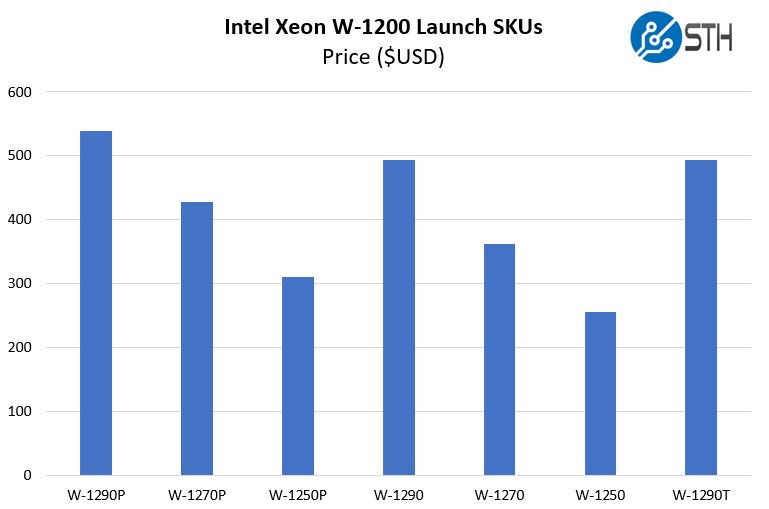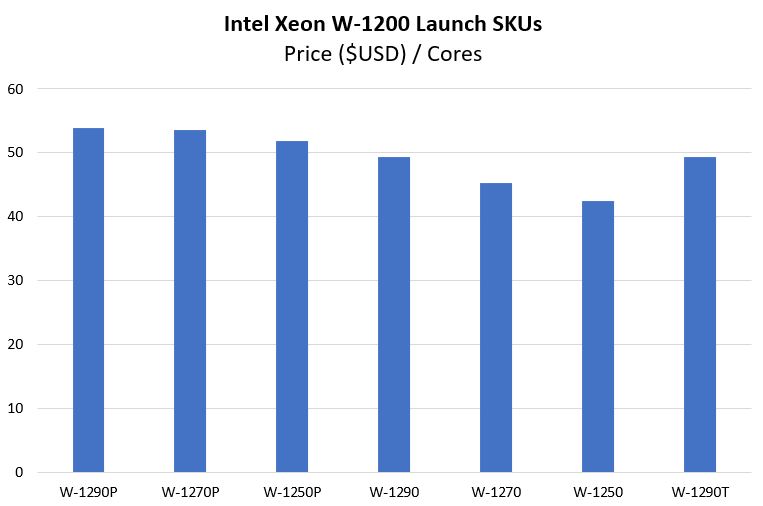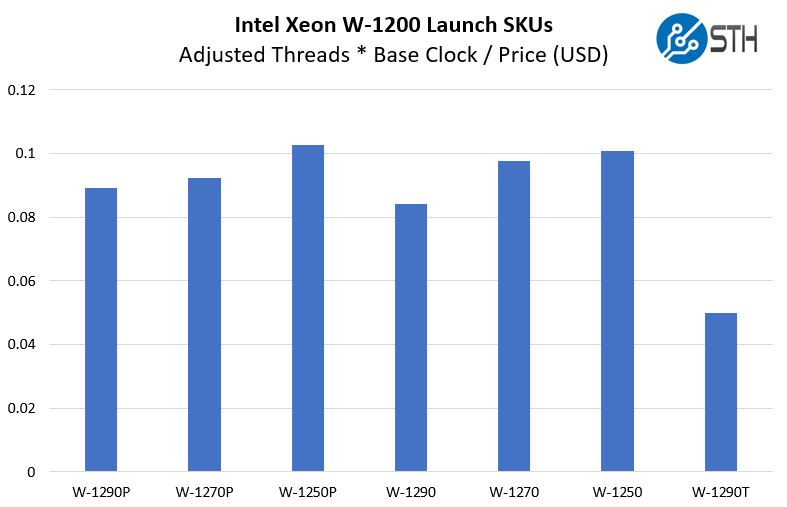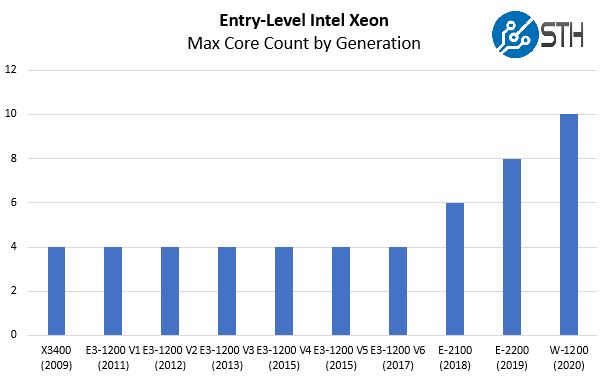Intel Xeon W-1290P Power Consumption
We wanted to post a few figures from our testing that show the real selling point of the chips, low power.
- Idle Power (Performance Mode): 39W
- STH 70% Load: 144W
- STH 100% Load: 168W
- Maximum Observed Power (Performance Mode): 184W
Although the TDP does not translate directly to increased power consumption, the Intel Xeon W-1290P we cannot recommend for extremely power-constrained environments like 1A in 110V or 120V rack deployments. You will run the risk of going outside of power limits in that type of hosting. For the low-cost colocation world, you will want to look lower in the stack.
Note these results were taken using a 208V Schneider Electric / APC PDU at 17.7C and 72% RH. Our testing window shown here had a +/- 0.3C and +/- 2% RH variance. You can read more about the differences in 120V or 208V for Servers, Storage, and Network Equipment. On lower-voltage hosting, we would expect slightly higher power consumption.
Intel Xeon W-1290P Market Positioning
Intel has seven launch SKUs in the Xeon W-1200 series if we exclude the embedded options. Of these SKUs, there are two primary families, the “P” and non-“P” SKUs. The “P” series offers higher power and therefore performance. Intel also has a 35W TDP SKU, the Xeon W-1290T which would be great in something like a Lenovo ThinkStation Tiny model. Here, the Xeon W-1290P is the top-end part.

Intel has a pricing strategy that captures value from the higher power/ performance SKUs. Here is what this P-series looks like versus the standard SKUs on a $/core basis.

Looking at a basic cost metric is a bit misleading. If one simply needs a lower core count and lower performance CPU. If you want performance, you want to see how much compute capacity a chip has, and how much that performance costs. Beyond our benchmarks, we can use a cost per clock and thread metric to look at how Intel is pricing the line:

The Intel Xeon W-1290P is not the best value, but there is something very interesting here. Due to the higher TDP and clock speeds, the Xeon W-1290P can actually be thought of as a better value than the Xeon W-1290. As such, and from what we have seen from the TDP impact, we would tell our readers that unless you are extremely thermally/ power limited in your platform, the Xeon W-1290P is our pick over the Xeon W-1290.
While we can see the appeal of the Xeon W-1250P, the other side of this is that these charts are only looking at the CPU side. In the context of a full system, the price/ performance ratio will favor the higher-end parts.
When comparing to AMD EPYC and Xeon Scalable lower-end parts, the bigger impact is at a system level. With more memory channels and PCIe lanes, motherboards are more complex and those motherboards cost more. The Intel Xeon W-1200 series still allows one to utilize lower-cost platforms when we take into account costs beyond the CPU. We showed that the AMD Ryzen series has performance that can compete. AMD does not have the systems relationships in the Xeon W-1200’s segment which will limit its appeal there. Also, the Xeon W-1290P has an iGPU which is not found on the enthusiast Ryzen CPUs so there is a capability gap that will prevent OEMs from using Ryzen for the time being. AMD may close the gap, but it is there. Likewise, the Xeon W-2295 also does not have an iGPU which can be a factor in some applications.
Final Words
Just to show the change in the market for the past four years pre/post the 2017 arrival of the AMD Ryzen CPU, here is the Xeon X3400, E3-1200, Xeon E-2200, and now the Xeon W-1200 series progression in this segment. For those that think that even with AMD not competing directly in this segment, that there is no impact here is the proof:

While AMD is not competing directly in the sockets of OEM professional workstations to the same degree it is on the enthusiast side, we are still seeing a benefit here. The Xeon W-1290P is derived from the Intel Core line which means that as Intel updates its Core line of CPUs to compete with AMD, we get these faster parts for the professional workstation market.
Overall, with a relatively large core count and TDP increase, we see the benefits of competition in this class of sockets. The Intel Xeon W-1290P brings an enormous generational upgrade which is hard to ignore. Some will balk at the higher TDP, but the industry trend is that chip companies across CPUs, GPUs, FPGAs, and other types of silicon are pushing TDP to increase performance. For Intel, it completely makes sense and there is even an option to de-rate the Xeon W-1290P to 95W if required. Intel has a great upgrade at the same $539 price point with these new chips.




…so, it’s kind a ‘deja vu’ e5-1650v2 with gimped pcie lines and memory channels 🙂
Don’t see a point of multi-thread comparison of cpu’s with different core count.
What would be more interesting (for me at least):
1) Relative single-core performance at the same frequency (3GHz for example).
I know it’s pretty hard to do with server mainboards, but if possible, i’d like to know how much faster 1 core of w-1290p compared to e-2288g at the same conventional 3ghz.
2) Absolute single-core performance at cpu’s max turbo boost. (when all other cores idle).
3) Full-load single-core performance (all cores at 100% load). And what is the cpu frequency in this situation.
Of course 10-core w-1290p is overall faster in multi-thread than 8-core e-2288g, and of course 18-core w-2295 is even “faster”. In quotes because each of the w-2295 cores is definitely NOT faster because of the much lower frequency at full load.
Yes, overall cumulative cpu performance is interesting, but performance of each core is what really makes the cpu “fast” – that’s interesting too.
Surely due to its low cost, low core count, but high frequency, this CPU could be fairly useful for GPU workstations/servers (eg just to feed the GPUs). So I was a bit surprised you never mentioned its PCIE lanes in this review? (I guess there is probably a reason that I am overlooking).
@Chris. Per the Ark page linked, it has 16 lanes. Which is because this is a desktop CPU with it’s ECC not fused off.
Intel segments the market too much. This is a CoreMumbleMumble CPU. But which Cove (or is it Creek or Peak or Crag or SlagHeap) core uarch? With the Other Companie one can at least draw a straight line fro. The product name to what is inside.
John,
A little disappointed about:
1- The inconsistent CPUs listed in benchmark results
2- The mixing of server CPUs (AMD EPYC) along with desktop CPUs
3- The complete lack of Ryzen 2000 or 3000 CPUs in the benchmark (you include a Ryzen 1600AF)
4- No comparison larger value proposition of Intel vs. AMD.
Chris, the platform is limited to 1x PCIe 16 or 2x PCIe wires. So max two crippled GPUs or one with full-speed of PCIe 3.0 version.
NotSlow, for ST performance comparison I would recommend to compare geekbench on the same OS with the same GB version.
Laugh, not so, e5-1650v2 was adult chip supporting RDIMMs, this is just sporty CPU with just poor UDIMM ECC support.
I can handle the crippling for a large last level cache, a pair of slots supporting Optane in storage mode is fine to feed a model, and a OCP 3.0 or Intel 100g. I would be running AVX codes on these with a presumably fat margin captured by Intel for Optane DIMMS, (oh why can’t we have a on board accelerated Intel 100g NIC? The other x8 lanes do me fine for a FPGA (I really can see this SKU being used under a Bluefield hypervisor solely for AVX codes. Iris graphics would have been perfectly lovely. Seriously these kinds of topologies need to be AICs that I can install in my POWER 9 RHEL/OpenShift environment. With a dma link across to the Accelerator Formerly Known As Quadro installed in the adjacent CXL slot. I would love to dedicate something like this (but upscale) to running Nuke / Baselight / Unity (per card, all wanting x64, me wanting POWER and ARM SVE for everything we write). I would spend more with Intel for CPU alone in this way.
BinkyTo: I usually find I can get a pretty good idea of “missing” data if I really read the review over. I know rtfa is so cliché but obviously delineation of the skus gives free product away that if I’ve need to show anyone else I’ll buy not claim I’m clever… I actually thought this review more generous than usual by mixing up the geometry of the comparables.